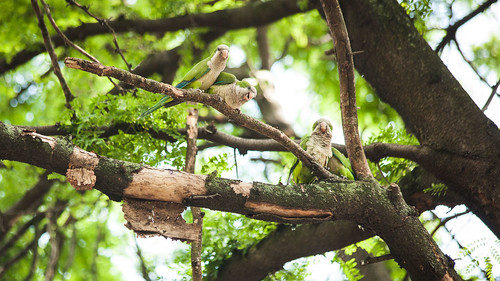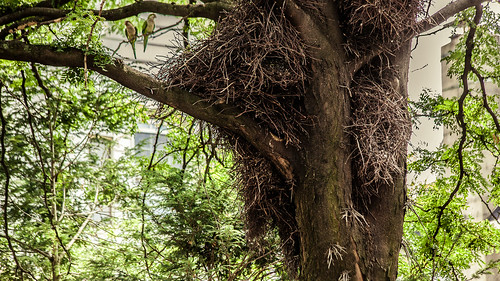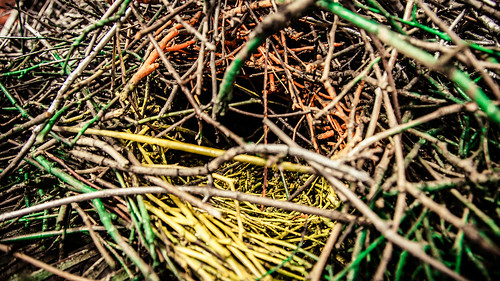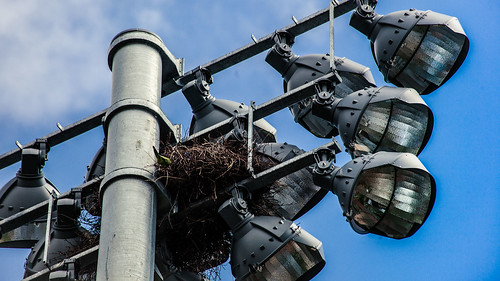Making It in a Strange Land
 Tuesday, October 16, 2012 at 11:30
Tuesday, October 16, 2012 at 11:30  Monk parakeets have found a home on campus. They appear as invaders, taking over a neighborhood and erecting tall dwellings seemingly overnight. Offspring and relatives soon follow, and their ensuing racket is not to be spoken of in polite company.
Monk parakeets have found a home on campus. They appear as invaders, taking over a neighborhood and erecting tall dwellings seemingly overnight. Offspring and relatives soon follow, and their ensuing racket is not to be spoken of in polite company.
That's monk parakeets for you. But, then again, they have so much to teach us about ourselves.
Frank Grasso, associate professor of psychology, has been studying the birds since 2000, when he took his position in the department. Seeing their nests in the lights surrounding the athletic field near his office on campus, he realized the birds might be a perfect medium for understanding a central tenet of human behavior.
 A nest on Glenwood Road."Their flexibility in adapting their behavior to their new environment, and the coordination of activity with one another, can be an informative mirror to our own behavior," Grasso says.
A nest on Glenwood Road."Their flexibility in adapting their behavior to their new environment, and the coordination of activity with one another, can be an informative mirror to our own behavior," Grasso says.
Monk parakeets are immigrants to New York City; their homeland is Argentina. Depending on who you listen to, the parakeets arrived in Brooklyn when they escaped from a broken crate at JFK Airport; or when pet store owners grew sick and tired of their chatter and released them. Either way, the birds should not have made it here. While the climate is compatible to that in Argentina, the area's sparseness of a particular cyanide-laden tree they use as protection against predators should have left them vulnerable to attacks.
But rather than fly off to a more appropriate locale, the early pioneers found a way to survive their first winter into spring and, remarkably, begin to thrive.
As Grasso points out, "Their presence in New York can seem bizarre, but the birds have found a way to adapt their native habits in ingenious ways."
The birds' first mission was to find suitable nesting spots. They quickly took to building up against the transformers in the college's athletic field lights as well as the terminals on street utility poles. The nests are an engineering feat, built tightly around the electrical terminals that make the interior toasty even in the fiercest gale.
 Ashley Worthington and the nests she is studying.Ashley Warmington, an undergraduate research assistant in Grasso's lab, spent two years meticulously pulling apart old nests that were gingerly taken down when renovation of the athletic field began. The college timed the move carefully to coincide with the end of the birds' breeding season and to give them enough time to build temporary nests.
Ashley Worthington and the nests she is studying.Ashley Warmington, an undergraduate research assistant in Grasso's lab, spent two years meticulously pulling apart old nests that were gingerly taken down when renovation of the athletic field began. The college timed the move carefully to coincide with the end of the birds' breeding season and to give them enough time to build temporary nests.
The old nests Warmington worked with look like a huge jumble of pick-up sticks. The biggest nest was about 10 feet wide and four feet high, containing different levels and a warren of chambers — envision an apartment building made of twigs. She pried her way through the tightly woven layers, color coding them in order to reconstruct their different functions later in the lab. The entrance of each nest was in the back on the bottom level and led to three individual chambers nearby. The floors in those chambers were covered with down that acted as a soft insulating carpet as well as other finely packed material that was strong enough to require a saw to break through. Warmington speculated that some of the bottom chambers may have been a nursery area, possibly used by more than one family. She collected DNA from feathers and droppings that would eventually determine how many individuals occupied each nest and what their relationship to each other might be.
 Color-coded twigs showing individual nest levels."This is what makes the birds interesting to a psychologist," Grasso says. "Most birds use nests for just one nesting season. But parakeets will occupy the same nest for years, pairing off with a mate, even bringing in others who may not be related. Their great organizational skill and cooperation with one another in nest construction and maintenance have helped them to survive and adapt to their new homes."
Color-coded twigs showing individual nest levels."This is what makes the birds interesting to a psychologist," Grasso says. "Most birds use nests for just one nesting season. But parakeets will occupy the same nest for years, pairing off with a mate, even bringing in others who may not be related. Their great organizational skill and cooperation with one another in nest construction and maintenance have helped them to survive and adapt to their new homes."
The nests' twigs are disproportionately from black cherry trees and are another indication of the birds' survival skills. Although they can be found in Brooklyn, the trees are more prolific in Argentina. When the birds find a black cherry tree in Brooklyn, they tend to cluster about it, building whole subdivisions. Monk parakeets favor these trees because they are laced with cyanide that is harmless to them but lethal to predators, including falcons, their most fiercest enemy who can fly and dive just as fast as they can. Hawks, too, are a bother, but they prefer squirrels and pigeons — much slower-moving meals — and are mostly easily evaded. Nevertheless, the birds take no chances, especially because the Brooklyn College campus is home to both a falcon and a hawk. They are constantly building, patching the walls, making them thick and impenetrable to foe and wind alike.
Grasso and his team are monitoring about 147 nests throughout Brooklyn, collecting data and observing the birds' behavior. On Avenue J, where there used to be an unbroken block of nests spanning several telephone poles, the team observed one bird moving from nest to nest, seeking admittance at several over the period of a few minutes. "There are all kinds of oddballs among them," Grasso says. "But we couldn't figure out what it was doing as it went from one to another. Maybe it was like an unwanted relative that got kicked out of the family nest and was just trying to find someone to take it in."
 Parakeet apartment building.The nests Warmington unraveled, like all the data the team has collected over the year, ended up in the Biomimetic and Cognitive Robotics lab that Grasso has established in James Hall. The DNA analysis collected from feathers and the thorough mapping of the nests are important tools in researching the birds' intelligence and behavior. But with the lab's ability to construct parakeet robots and a computer simulation of their customs in a controlled environment, the researchers have been able to gather more insight into the reasons behind their behavior.
Parakeet apartment building.The nests Warmington unraveled, like all the data the team has collected over the year, ended up in the Biomimetic and Cognitive Robotics lab that Grasso has established in James Hall. The DNA analysis collected from feathers and the thorough mapping of the nests are important tools in researching the birds' intelligence and behavior. But with the lab's ability to construct parakeet robots and a computer simulation of their customs in a controlled environment, the researchers have been able to gather more insight into the reasons behind their behavior.
As Grasso points out, "Monk parakeets are showing up in new places all the time. They just found them in Rome and England. They're even in Newfoundland. They wouldn't be able to do this successfully without cooperating with one another. That's what this study has to show us: the value of organization and the fundamentals of control that enable all of us to survive."
 Nest in athletic field light.Soon after the new lights were installed on the recently completed athletic field, parakeets were sighted settling back in around one of the lights. Within weeks, the nest looked to be a foot high and, in the weeks that followed, several more layers were added. A chatter of purposeful squawks once more rings out across the field.
Nest in athletic field light.Soon after the new lights were installed on the recently completed athletic field, parakeets were sighted settling back in around one of the lights. Within weeks, the nest looked to be a foot high and, in the weeks that followed, several more layers were added. A chatter of purposeful squawks once more rings out across the field.
To see the monk parakeets in action, watch some videos on YouTube or visit their Facebook page.
 Myiopsitta monachus - Monk Parakeet | in
Myiopsitta monachus - Monk Parakeet | in  Research,
Research,  Urban parrots
Urban parrots 
